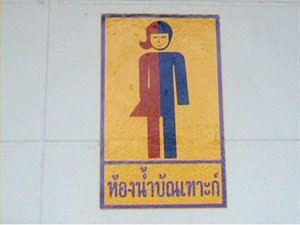
Kathoey, a Thai word of Khmer origin, refers to a male to female transgender person or effeminate, cross-dressing gay. Nearly all katoeys dress as women and many that can afford it will undergo hormone treatment and surgical procedures such as genital reassignment, Adam’s apple reductions and breast implants to cultivate their feminine appearance. Kathoeys are (very) often indistinguishable from women and there are numerous tales of the unsuspecting westerner who hooks up with a kathoey in the mistaken belief that their glamorous companion is female.
Frequently attracted to the entertainment, restaurant, retail and fashion trades, popular work for kathoeys includes traditionally feminine occupations in cabarets and bar shows, hair & beauty salons, and fashion houses - or as prostitutes, although not all. An attractive, if occasionally stubbly, ladyboy works in the plumbing department of our local hardware store.
Kathoeys are usually extremely glamorous and wear stunning outfits. Many Thai singers, models and movie stars are kathoeys. There are several national beauty contests for kathoey, and the winners are often posted side-by-side with winners of female beauty pageants.
Tanyarat Jirapatpakorn was crowned Miss International Queen 2007 at the transsexual beauty pageant in Pattaya, here flanked by the runners up from Philippines (L) and Brazil (R)
Nong Toom is probably the best-known kathoey in Thailand. She is a former Muay Thai champion and has also worked as a model and actress. As a young boy, she was aware of her gender-identity and at the age of 16 was already dressing as a woman and taking hormones. After a short period as a Buddhist monk, she started to train as a boxer, and eventually joined a boxing camp in Chonburi. Her goal was to make enough money to support her poor parents and to pay for a sex-change operation. After retiring from the professional ring, Nong Toom underwent gender reassignment surgery and her life was portrayed in the 2003 film 'Beautiful Boxer'.

After a night out in Chaweng, with perhaps a visit to Christy's Cabaret, it might seem that Thailand has more than its fair share of ladyboys, but this is not the case. Thailand is the most open society in Asia, and with its ready acceptance of all ways of life, sexual lifestyles that may stray from the orthodox formula are not hidden from view as in most other countries. The elemental Buddhist principal, that of tolerance, also plays its part in the acceptance and visibility of kathoeys in Thai society. Many devotees believe that being born with such ambiguous sexuality is a result of bad karma and the outcome of wrongdoing in a former life for which they are now expiating their sins. It follows that kathoeys are due pity rather than censure; acceptance rather than dismissal from normal social intercourse.
Legal recognition of Kathoeys' status in society is not so charitable and they suffer considerable discrimination. Even after gender reassignment Kathoeys are not allowed to describe themselves as female and their passport, among other important documents, must show their birth gender. Should they fall foul of the law, kathoeys' lives become doubly difficult as they will be sent to an all male prison. Some families, too, appear to have an ambiguous attitude about having transgender offspring, often disowning them.
Official acceptance is glacially slow, but a government funded education authority has permitted a high school in rural north eastern Thailand to set the ball rolling by building a toilet for kathoeys. The Kampang School in Isarn recently conducted a survey among their students which revealed that nearly 260 students considered themselves kathoeys. Accordingly, the school decided to create a unisex toilet for their student-ladies of the third gender.


















